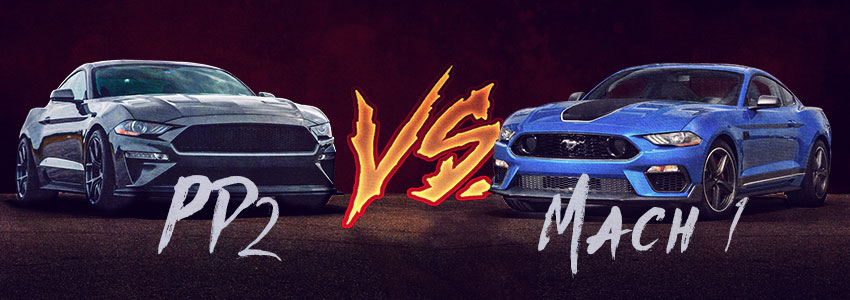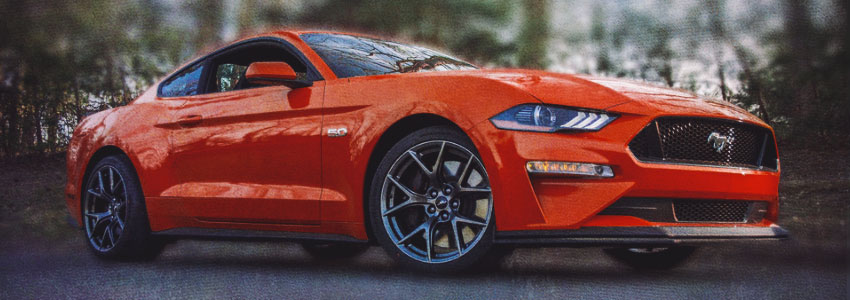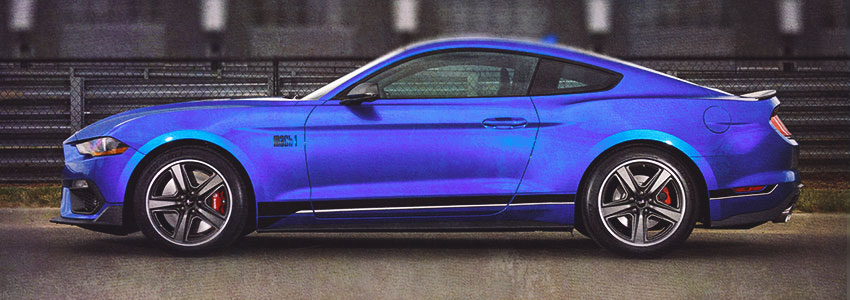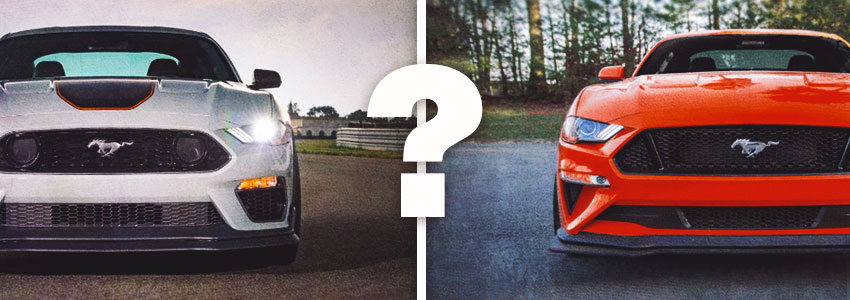In the world of high-performance Mustang variants, the 2021 model year represents a
significant transition. For years enthusiasts reveled in a wide variety of optional
packages and limited-production models, but many of those — including the Mustang
Bullitt and Shelby GT350 — drove off into the sunset. It was a good run, but Ford knew
there would be a big gap to fill between the Mustang GT and the Shelby GT500. That set the stage for the return of the Mach 1 model after a 17-year hibernation. It was
certainly sad to see those variants leave the order sheet, but the Mach 1 shows great
promise. It certainly has several big shoes to fill, including another option that faded
from availability that doesn't get quite the same level of hype — the Mustang GT
Performance Pack Level 2.
PP2 History Breakdown
New Kid On The Block
Which Is For You?
The Numbers
It was the value proposition for the corner-carving crowd, and was born from Ford engineers'
quest to always keep iterating for improved performance. They knew there was enough
space between the Mustang GT Performance Pack and the Shelby GT350 to offer something
that bridged the gap. To achieve that goal, engineers spent nights and weekends diving into the parts bin to lift
the Brembo six-piston front brakes and Michelin Pilot Sport Cup 2 tires from the Shelby
GT350. Meanwhile, they relied on computer-aided design and 3D printing to develop a
front splitter that delivers 24 pounds of downforce at 80 mph. Along with stronger stoppers and improved aerodynamic, engineers turned up the dial on the
sway bars, which are 12-percent stiffer than the Performance Pack Level 1 bars in front
and a whopping 67-percent stiffer in the rear. Likewise, the coil springs are 20-percent
stiffer up front and 13-percent stiffer out back and they lower the car by half an inch
as compared with the PPL1. A K-brace bolsters the chassis up front, providing a solid
foundation for the stiffer suspension to work from. While nothing changes under the hood, as the PPL2 still sports Mustang GT-level outputs of
460 horsepower and 420 lb-ft of torque, nearly every other aspect of the car benefits
from revised calibrations. Engineers tweaked the knobs on the ABS control, stability
control, electronic power assist steering and MagneRide. They all benefitted from
'track-inspired' calibrations meant to maximize the package hardware. Though it received a larger radiator, the real weakness of the PPL2 for track rats was the
lack of additional cooling for the engine, transmission, and rear end. Enthusiasts could
certainly add those items, but out of the box, this package wasn't really up to
sustained laps, especially on hot summer days. That said, the PPL2 delivers a great combination of grip and a compliant suspension that made
it easy to toss the car through the corners. The brakes are up to the task and the Gen 3
Coyote power is more than adequate. If only it had the extra Bullitt power, this package
might have made more of name for itself, but at only $6,500 more added to the price of a
Mustang GT, it struck a nice balance of value and performance. Which brings us to the car that it would appear is replacing the Bullitt, PPL2, and Shelby
GT350. While most people think of the Mach
1 as the successor to the Shelby, it is
probably more accurately a replacement for the Bullitt and the PPL2, as it still
features a 5.0-liter powerplant under the hood. In fact, that Coyote is the same
480-horsepower engine that motivated the more street-oriented Bullitt. The similarities
between those two cars end there, however. When it comes to how the PPL2 stacks up to the 2021 Mustang Mach 1, they actually share some
braking components, including the booster and six-piston front Brembos. From there,
however, the Mach 1 benefits from its predecessors in much the same way that the PPL2
did before it debuted in 2018. While its styling pays tribute to the Mach 1 legacy,
underneath it borrows from every S550 performance variant to date. In addition to the aforementioned Bullitt engine and PPL2 brakes, it leans heavily on the
outgoing and current Shelby Mustangs. While the GT350 left a legendary mark in pony car
history, some of its heritage carries on with the Mach 1. Not only does the engine wear
the GT350 intake manifold, but this engine is track ready thanks in part to the addition
of the Shelby's engine oil cooler. It shares the same front subframe and rear subframe
with stiffer bushings and stepping up to the optional Handling Package adds the same
tire setup. Most significant of the parts sharing, however, is the standard Tremec 3160
six-speed manual transmission complete with short-throw shifter and dual-disc clutch.
Reaching above its pay grade, the Mach 1 even benefits from some of the GT500's engineering
prowess. Further bolstering its on-track capabilities are the rear-axle cooling system,
rear toe-link, rear tire spats, and lower diffuser from the halo Shelby. Those stepping
up the optional Handling Package also gain the GT500's Swing rear wing with Gurney flap.
That flap is part of a comprehensive aerodynamics makeover that improves downforce by 150
percent versus the PPL1 and 22 percent more downforce in its base form. Creating that
improvement is a belly pan that extends 20 percent farther back and wears an underwing
and air foils for brake cooling. Its grilles balance aerodynamics and cooling, while the
complementary rear spoilers optimize lift balance. In all the improved aerodynamics and cooling upgrades borrow from both Shelbys, enhance the
Mach 1's cooling capabilities, which help it achieve the target of the being the “the
most track-capable 5.0-liter Mustang ever” by delivering more track capability and
durability. Apparently, the Mach 1 will hang with a GT350 on a tight road course where
the Shelby can't flex its full Voodoo muscle, and that is saying something as Car and
Driver found that the PPL2 delivered more grip than a GT350 — 1.13 g versus 1.09 g
respectively — but the GT350 lapped the same track two seconds faster than the PPL2 in
its test, according to Car & Driver. So, on paper, the 2021 Mach 1 would seem to have all the advantages on a road course. Though
it only has 20 more horsepower, it takes advantage of all of Ford's S550 chassis and
suspension tuning to this point. With the optional Handling Package, it should really be
no contest in the corners, but there is something else to consider. The Mach 1 is
available with something that none of the cars it replaces offered — an automatic
transmission. Cars with that option should perform quite well in a straight line as
well. We'll have to wait until the spring of 2021 to see how it performs in the real world,
however, but it's clear that performance advantage will cost a bit more. With a base
price of $52,915, the Mach 1 is $7,340 more than a Mustang GT with the PPL2, but you get
a lot more performance content for that price. Stepping up to the Handling Package adds
another $3,500 to the window sticker, which really makes the PPL2 look like a bargain.
Manual Mach 1s with the Handling Package start at $56,415, while Handling Package Mach
1s with automatics start at $58,010. Of course, whether you own a PPL2 and want to step it up to hang with a stock Mach 1 or you
want to take that new Mach 1 you have on order to a new level, the team at Steeda
developed a full complement of upgrades to help your S550 be all it can be. Source: Car & Driver | FordMustang Mach 1 vs GT PP2


GT Performance Package - Level 2 History & Breakdown

2021 Mustang Mach 1 - The New Kid On The Block

Which Is For You - PP2 or Mach 1?
Mustang Mach 1 vs GT Performance Package 2 - The Numbers
Vehicle Specification
2018-2020 Mustang GT PP2
2021 Mustang Mach 1
Base Price
$44,685
$52,915
Drivetrain Layout
Front Engine, RWD
Front-engine, RWD
Engine
"Coyote" Gen III 5.0L Ti-VCT 32V V8, Aluminum Block &
Cylinder Heads
Upgraded "Coyote" Gen III 5.0L Ti-VCT 32V V8, GT350 Intake Manifold,
Throttle Body, Intake; Revised Calibration
Valvetrain
32V DOHC TI-VCT
32V DOHC TI-VCT
Displacement
5.0L, 302 Cubic Inches
5.0L, 302 Cubic Inches
Compression Ratio
12.0:1
TBA
Horsepower
460 hp @ 7,000 rpm
480 hp @ 7,000 rpm
Torque
420 lb-ft @ 4,600 rpm
420 lb-ft @ 4,600 rpm
Redline
7,500 RPM
TBA
Transmission
Getrag MT-82 6-speed Manual Transmission
TREMEC TR-3160 6-speed Manual Transmission (std.) or
10R80 10-Speed Automatic Transmission (opt.)
Rear Axle Ratio
Torsen 3.73
Torsen 3.73 (manual) or Torsen 3.55 (auto)
Front Suspension Configuration
MagneRide Dampers, Struts, Coil Springs, Adj Shocks,
Anti-Roll Bar
MagneRide Dampers, Struts, Coil Springs, Adj Shocks,
Anti-Roll Bar
Rear Suspension Configuration
MagneRide Dampers, Coil Springs, Adj Shocks, Anti-Roll
Bar
MagneRide Dampers, Coil Springs, Adj Shocks, Anti-Roll
Bar
Brakes, Front & Rear
Brembo 6-Piston Front, Single Piston Rear
Brembo 6-Piston Front, Single Piston Rear (Red or Orange Painted,
opt.)
Wheels
19” x 10.5” F / 19” x 11” R, Aluminum Alloy
19” x 9.5” / 19” x 10”, Tarnished Dark-painted aluminum (std.)
19” x 9.5” / 19” x 10”, Magnetic-painted aluminum (opt.)
19" x 10.5" / 19" x 11", Tarnished Dark-painted aluminum
(Handling Pack)
Tires
305/30R19 103Y / 305/30R19 104Y, Michelin Pilot Sport
Cup 2
255/40R19 / 275/40R19, Michelin Pilot Sport 4S (std.)
305/30R19 / 315/30R19, Michelin Pilot Sport Cup 2
(Handling Pack)
Related Articles




